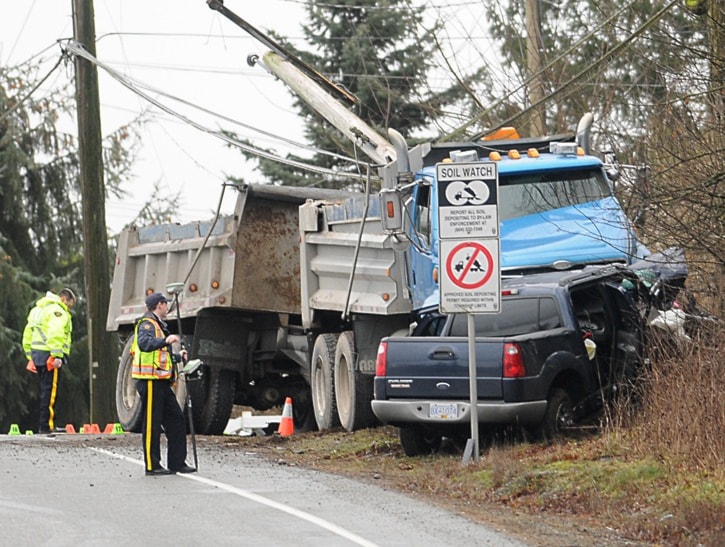A dump-truck driver who crossed a double-yellow line, killing a South Surrey man in 2011, took a “calculated, deliberate risk” that resulted in the head-on collision, Surrey Provincial Court heard Tuesday.
Glen Edward Theriault’s decision to cross out of the westbound lane in the 19800-block of 16 Avenue and travel in the wrong lane, leading to the early-morning collision that killed Jim Neiss, 59, on Jan. 18 was not the action of “a reasonable person,” Crown prosecutor Winston Sayson told Judge Paul Dohm during closing arguments.
The trial had been rescheduled from Oct. 7 after the defence asked to recall a forensic collision reconstructionist who had attended the scene. Defence counsel Rishi Gill had told Dohm he had worded a question poorly and asked to clarify the evidence.
This week, Gill asked Dohm to “disregard” or “void” previous testimony and refer to the witness’s latest answers, along with videos and photos he had taken on Sept. 29.
However, Dohm denied the request, telling Gill that “just because you don’t like someone’s answers” doesn’t mean he would void the testimony, adding the witness could change his answers, but it “calls into question his credibility and reliability.”
 Later, Gill argued that while “actus reus” (‘guilty act’) had occurred when Theriault had crossed the westbound lane to overtake another car, the “mens rea” (‘guilty mind’) was not proven beyond a reasonable doubt.
Later, Gill argued that while “actus reus” (‘guilty act’) had occurred when Theriault had crossed the westbound lane to overtake another car, the “mens rea” (‘guilty mind’) was not proven beyond a reasonable doubt.
“Theriault thought the road was clear ahead,” Gill told the court. “Just passing a double-yellow solid is not enough (to equate a dangerous-driving conviction).”
Gill added that given Theriault’s belief the road was clear ahead, it was not a “marked departure of a reasonable person” to cross the double-yellow line to pass a car.
“A reasonable driver is not a perfect driver,” the defence lawyer said.
Gill said the collision should be considered an act of “simple negligence,” referring to statements Theriault made at the scene that the attempt to pass was a “bad three-second decision” and that he didn’t see the vehicle approaching in the eastbound lane.
Gill added that had there not been a fatality, Theriault may not even have been charged with negligence.
Sayson argued that a reasonable person would know a double-yellow line is a clear indicator that it is not safe to pass, and that Theriault’s state of mind was key.
Sayson cited comments Theriault made to Langley RCMP about being late to drop his truck off in Delta and concerns about losing his job as a result.
“All of that shoots down that he thought it was safe to pass,” Sayson said. “It doesn’t excuse that you killed somebody to bring a truck to Delta… A reasonable person knows what a double-yellow line means. Of course you can’t see, that’s what a double-yellow line means. You don’t pass.”
Gill asked that Theriault’s comments relating to the crash being a “bad three-second decision” and that he did not see the other vehicle should be “adopted specifically.”
“Those two statements are what should be given the most weight,” the defence lawyer argued.
However, the judge rejected that argument.
“(You want me to give) the greatest weight to the ones that help you and ignore the ones that don’t?” Dohm said.
Sayson noted that in order for the evidence to be considered, the judge must take the statements in their entirety.
The trial is scheduled to continue Friday.
